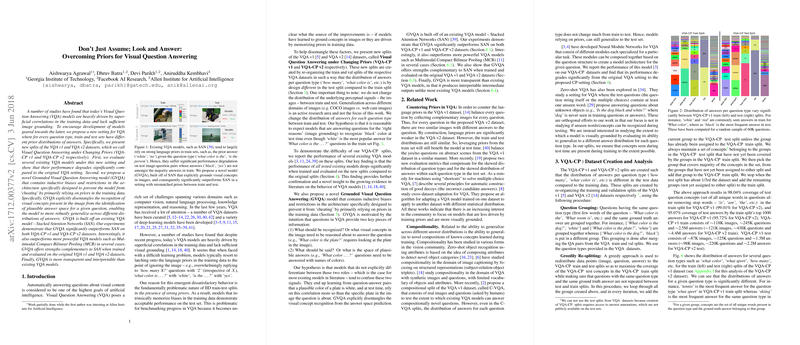Analysis of "Don't Just Assume; Look and Answer: Overcoming Priors for Visual Question Answering"
The paper "Don't Just Assume; Look and Answer: Overcoming Priors for Visual Question Answering" addresses a critical shortcoming in current Visual Question Answering (VQA) models: their excessive reliance on language priors rather than image content. This approach often results in models that fail to robustly interpret visual data, leading to inadequate performance when exposed to variations in answer distributions. The authors propose a novel dataset partitioning and a grounded VQA model to rectify these issues.
VQA-CP Dataset
The authors introduce Visual Question Answering under Changing Priors (VQA-CP) with distinctive train and test data distributions. This dataset, comprising VQA-CP v1 and VQA-CP v2, is derived from VQA v1 and VQA v2 by altering the answer distributions across question types for train and test sets. This novel splitting aims to challenge models that primarily rely on priors, ensuring that true progress in VQA is benchmarked against more visually-grounded understanding.
Grounded Visual Question Answering Model (GVQA)
The paper presents GVQA, a model designed to distinguish between recognizing visual concepts and predicting plausible answers. Unlike traditional models, GVQA incorporates architectural constraints to minimize reliance on data-driven language priors. At its core, GVQA utilizes:
- A Visual Concept Classifier (VCC) to recognize visual elements in the image.
- An Answer Cluster Predictor (ACP) to determine feasible answer types.
- A disentangled process for handling yes/no questions as visual verification tasks.
These components synergize to enhance model robustness across varying answer distributions and improve interpretability.
Experimental Results
Empirical assessments reveal that GVQA outperforms traditional models such as Stacked Attention Networks (SAN) and Multimodal Compact Bilinear Pooling (MCB) on the VQA-CP datasets. GVQA significantly enhances performance, particularly in avoiding the degradation seen in conventional models under the same conditions.
Notably, GVQA shows superior results on yes/no questions, highlighting its capability in contexts requiring transparent decision-making processes. While its performance on traditional VQA datasets does not surpass language-prior-dependent models due to their tuned design for existing data structures, GVQA provides complementary strengths when combined in ensemble methods.
Implications and Future Directions
This work's implications extend beyond incremental advancements in VQA; it inspires a more principled approach to building models that inherently understand and interpret visual stimuli. By facilitating a setting where language priors cannot be exploited, GVQA and VQA-CP propel the domain towards more authentic progress.
Future research may focus on leveraging GVQA's interpretability and robustness while balancing the strengths of existing models. Refining architectures to unify visual grounding and inductive language biases could mitigate their weaknesses and unlock further interpretive power, driving forward the state-of-the-art in AI comprehension of visual data.
